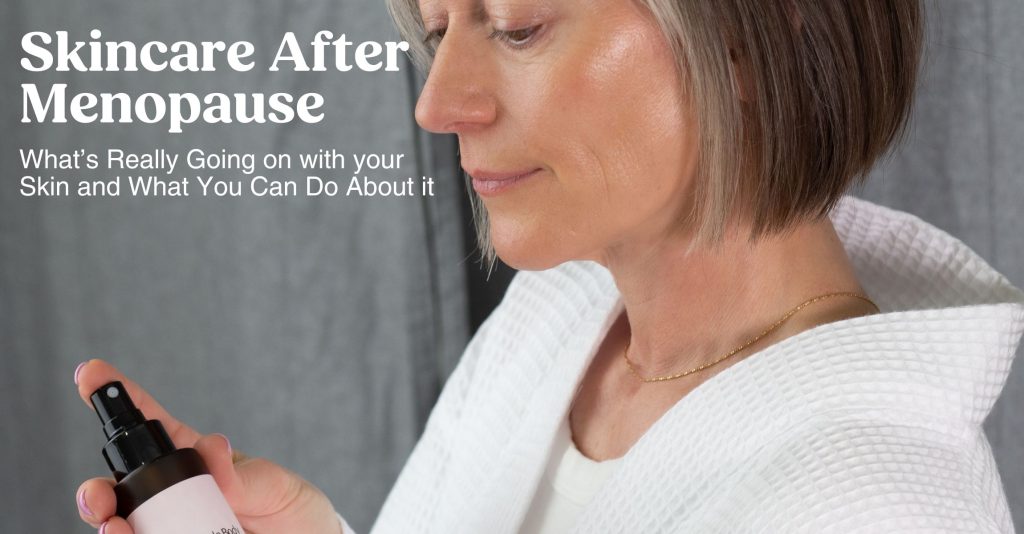
Skincare After Menopause
What’s Really Going On With Your Skin (and What You Can Do About It)
Let’s talk about something that doesn’t get enough airtime: skin after menopause.
Not in a “here’s how to look 25 forever” kind of way—but in a “what’s actually happening to my skin, and how can I take care of it now?” kind of way. Because there are changes. They’re normal. They’re rooted in science. And yes, there are gentle, natural ways to support your skin through them.
First things first: what is menopause doing to our skin?
Here’s the short version: your estrogen levels drop dramatically. And since estrogen has a hand in just about everything when it comes to skin—collagen production, hydration, elasticity, wound healing, even pigmentation—you’ll likely notice some shifts.
Here’s what that can look like:
-
Thinner skin: You might feel like your skin bruises more easily or just doesn’t have that same “bounce” it used to.
-
Dryness and irritation: Less oil production = more dryness. Your skin’s barrier also becomes more fragile, making it easier for irritants to sneak in.
-
Sagging and fine lines: Collagen and elastin—those two key structural proteins—start declining faster after menopause, which can lead to a more pronounced loss of firmness.
-
Slower healing and more sensitivity: Yep, your skin might be more reactive and slower to recover from breakouts, scratches, or irritation.
-
Shifts in tone and pigmentation: Some women notice more unevenness in tone or new sunspots that seem to appear out of nowhere.
None of this means anything is wrong with you. This is biology, not bad skin. Your body is doing what it’s supposed to do. But that doesn’t mean you have to settle for itchy cheeks or skin that feels dry no matter what you put on!
So… what does post-menopausal skin need?
It needs support. Nourishment. Hydration. And a little grace. You don’t need a 10-step routine or anything invasive to feel good in your skin again. You just need a few key ingredients that work with your skin—not against it.
1. Ceramides
Ceramides are naturally occurring lipids (fats) that make up the “mortar” between your skin cells. After menopause, your skin produces fewer of them, which weakens your skin barrier and leads to dryness and irritation. Replenishing ceramides helps seal in moisture and protect from the elements.
→ Try: A serum or tonic with phytoceramides (plant-based ceramides) to restore skin barrier function.
Products that contain ceramides: Barrier Defense Serum and Brighten + Boost
2. Hyaluronic Acid (HA)
Think of HA as a sponge that holds water in your skin. It can hold up to 1,000 times its weight in water—but levels decline with age. A good HA serum (especially one with both high and low molecular weights) helps plump up the skin, reduce the look of fine lines, and keep skin supple.
→ Bonus tip: Always apply HA on damp skin and follow it with a moisturizer to lock in hydration.
Products that contain Hyaluronic Acid: Barrier Defense Serum and Wrinkle Defense Serum
3. Antioxidants like CoQ10 and Vitamin C
Your skin has its own antioxidant defenses, but they take a hit post-menopause. That’s where topical antioxidants come in. They fight free radicals (from sun, stress, and pollution), brighten the skin, and support collagen production.
→ Try: A daily facial oil or serum with CoQ10, sea buckthorn, or bakuchiol (a natural retinol alternative).
Products that contain CoQ10, Bakuchiol and Vitamin C: Age Defense Serum and Beauty Balm
4. Fatty acids and botanical oils
Oils like avocado, camellia, meadowfoam, and pomegranate seed help strengthen the skin barrier, replenish lost moisture, and soften dry patches without feeling greasy. Your skin’s natural oil production slows way down after menopause—so giving it a little help can make a world of difference.
Products that contain Fatty Acid Oils: Age Defense Serum, Nightly Face Serum, Pomegranate Facial Oil
5. Gentle exfoliation
Cell turnover slows with age, and dead skin cells can build up, making skin look dull or feel rough. But aggressive scrubs and acids can backfire on fragile post-menopausal skin.
→ Go for something like a fruit-based enzyme mask once or twice a week—just enough to nudge things along.
Products that contain Enzymes: Pineapple + Papaya Enzyme Mask and Pumpkin Enzyme Mask
The Routine: Simple, Supportive, and Science-Backed
Want a natural routine that doesn’t overwhelm your skin (or your schedule)? Here’s a solid 5-step plan that works beautifully for post-menopausal skin:
-
Cleanse gently — Choose a pH-balanced foaming face wash or a cleansing oil that respects your microbiome.
-
Mist or tone — Use a tonic that hydrates and preps your skin for serum (look for aloe, chamomile, or peony extract).
-
Layer a hydrating serum — Hyaluronic acid + ceramides = happy skin.
-
Seal with a moisturizer or facial oil — Something rich in fatty acids to lock in hydration.
-
Use sunscreen every morning — Mineral-based SPF, always. Sun damage = collagen loss.
That’s it. Simple, but powerful.=
One last thing…
There’s a lot of messaging out there that says aging skin is something we need to “fix.” We don’t buy that. Yes, your skin is changing—and yes, you can support it in beautiful, nourishing ways. But this phase of life is about becoming, not fading. It’s about listening to your body and working with it—not chasing some impossible ideal.
Take care of your skin the way you’d care for a dear friend: with attention, kindness, and a whole lot of love.
xoxo
Jewels
